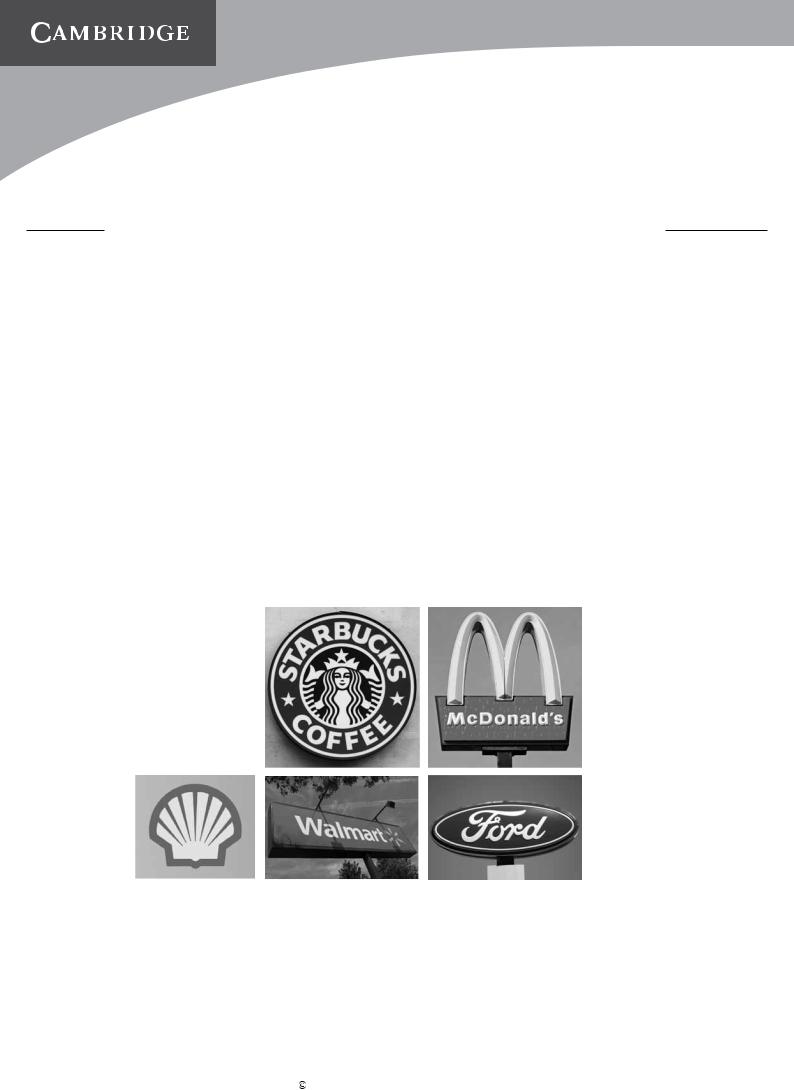
Cb English for Marketing Case-study
.pdf
Professional English
Cambridge English for
Marketing
International |
CASE STUDY |
|
|
|
|
UNIT 4 customer communications |
|
|
|
|
|
 Part 1 The challenges of international communication
Part 1 The challenges of international communication
Read the six examples of international launch campaigns (A–F). Then answer the following questions.
1What did all these campaigns have in common?
2Which campaign(s) …
a showed a lack of local cultural knowledge? b made a language translation error?
3How could these problems have been solved?
4What other factors should international marketers consider when expanding products and services internationally?
FAMOUS MARKETING MISTAKES
A
Scandinavian vacuum manufacturer Electrolux used the following in an American campaign: ‘Nothing sucks like an Electrolux.’(In the U.S., ‘sucks’ means ‘bad’ or ‘terrible.’)
B
When Gerber started selling baby food in Africa, they used the same packaging as they did in the U.S., with a beautiful baby on the label. Later
they learned that in some parts of Africa, it is normal for companies to put pictures on the label of what’s inside for those consumers who can’t read.
C
An American T-shirt maker in Miami printed shirts for the Spanish market which promoted the Pope’s visit. Instead of ‘I saw the Pope’ (el papa), the shirts read ‘I saw the potato’ (la papa).
D
Pepsi’s ‘Come alive with the Pepsi Generation’ translated into ‘Pepsi brings your ancestors back from the grave’, in Chinese.
E
The Coca-Cola name in China was first read as ‘Ke-kou-ke-la’, meaning ‘Bite the wax tadpole’ (a tadpole is a baby frog) or ‘female horse stuffed with wax’, depending on the dialect.
F
When Parker Pen marketed a ball-point pen in Mexico, its ads were supposed to have read, ‘It won’t leak in your pocket and embarrass you.’ Instead, the
company thought that the Spanish word ‘embarazar’ (to become pregnant) meant to embarrass, so the ad read: ‘It won’t leak in your pocket and make you pregnant.’
source: http://www.digitaldreams.com
|
Cambridge English for Marketing |
Cambridge University Press 2011 |
|
|
19 |
Photocopiable |
|||
www.cambridge.org/elt/englishformarketing |
||||
|
|
|||

UNIT 4 International customer communications
 Part 2 International communication strategies: Branding
Part 2 International communication strategies: Branding
a In pairs, discuss the questions below.
1What do you understand by the term global brand?
2What do you think are the top 10 global brands today?
3Why might a global brand fail?
b Choose one of these brands from the list you made for question 2 (Exercise 2a) and then discuss why you think it has been so successful in the global marketplace.
c Match a brand strategy available to international marketers (1–5) with the correct definition (a–e).
1 |
Brand extension |
a |
changing the appeal of a brand (and sometimes |
|
|
|
modifying the actual product), in order to attract |
|
|
|
new market segments |
2 |
Brand repositioning |
b |
restricting the marketing of a brand to a relatively |
|
|
|
small and restricted geographical area or |
|
|
|
developing a brand for a specific national market |
3 |
Global branding |
c |
standardising the name and image of a product |
|
|
|
across worldwide markets |
4 |
Local/national branding |
d |
updating a brand name or image to appeal to |
|
|
|
different market needs or requirements |
5 |
Rebranding |
e |
use of an established brand name on a new |
|
|
|
product within the same market or product |
|
|
|
category |
d Think of examples of companies that have used these strategies. Then in pairs, discuss the advantages and disadvantages of each one.
 Part 3 Do local brands have a future?
Part 3 Do local brands have a future?
a You are going to read a blog entry about the future of local brands. First, look at the statements (a–f) below. Then in pairs, say:
b c
●●to what extent you agree or disagree with each of the writer’s statements
●●which part of the world you think the writer is from
●●whether or not you think these statements suggest that the writer has a ‘global’ perspective
aEvery brand that is global today started as a local brand
bA global culture dominates in fields of interest to young people
cBrands which blend local and global cultures will be the norm in the future
dThe type of product category determines whether a brand should follow a global or local approach
eMarketing communication, whether for local or global brands, needs to take account of local culture
fyou only have to look at Japan and Korea to realize that cultural identity is resistant to change
Now complete the blog entry (page 21) with the statements a–f from Exercise 3a.
In small groups, discuss the following questions.
1How would you answer the writer’s question at the end of the blog?
2What product categories do you think the top future global brands will belong to? Justify your choices.
|
Cambridge English for Marketing |
Cambridge University Press 2011 |
|
|
20 |
Photocopiable |
|||
www.cambridge.org/elt/englishformarketing |
||||
|
|
|||

UNIT 4 International customer communications
If today’s young people come to prefer global brands, will there be a place for local brands in 20 years’ time? Without doubt, today’s young people live in a world that is far more connected and mobile than the one their parents grew up in. Even if they don’t have the opportunity for international travel, many teenagers know people from other countries and through them are directly exposed
to foreign cultu res. Others learn about the world beyond their country’s borders through school and the media. 1 [ ]
There used to be a prevailing expectation that as standards of living rose around the world, we would all become more similar. However, 2 [ ]. And it is worth noting that those two countries are the most challenging for foreign marketers.
I suspect China and India will present the same types of challenges. When it comes to popular culture, Indians prefer Bollywood to Hollywood, and though Bollywood happily adopts themes and ideas from the West, it serves them up in a way more appropriate to
local interests. 3 [ |
|
] |
||
|
||||
4 [ |
|
] Technology brands tend to find an advantage in a global |
||
approach, because they serve needs that are consistent across countries. Food and drink brands are usually local, because they serve specific people in specific places with particular needs and expectations.
5 [ |
|
] Very few ads have the power to travel globally because |
||
communication is intrinsically bound up with culture. |
|
|||
There is one more compelling fact to consider. 6 [ |
|
] Even |
||
Google, Amazon, and Facebook started in the United States and have found it tough to compete in other countries with very different cultures, especially when a local brand launched before
they could get there. There will always be new local brands, created in someone’s garage or bedroom, that find a way to challenge the status quo and create a strong local presence before going global. And who are the people most likely to adopt these brands? The younger generation looking for the next new thing.
So those are my thoughts. What are yours? Is the future of brands global, local, or a mix?
Text adapted from ‘Straight talk with Nigel Hollis’ http://www.mb-blog.com/index.php/2010/04/04/do-local-brands-have-a-future/
 Part 4
Part 4
You are working in the international marketing department of a company which wants to increase sales of its main brand by expanding abroad. You have been asked to input ideas into the most appropriate brand strategy and to help devise a promotional campaign to support the chosen strategy. Working in small groups, consider the following:
●●choosing a local consumer brand from your own country
●●selecting your export market(s) and appropriate brand strategy
●●deciding whether to adapt or standardise your promotional campaign for your chosen markets and justify your choice
●●drafting ideas for your promotional plan thinking about media choices and your promotional mix
|
Cambridge English for Marketing |
Cambridge University Press 2011 |
|
|
21 |
Photocopiable |
|||
www.cambridge.org/elt/englishformarketing |
||||
|
|
|||

Professional English
Cambridge English for
Marketing
International |
TEACHER’S NOTES |
||
|
|
|
|
UNIT 4 customer communications |
|
|
|
|
|||
Before you begin …
Write two columns on the board with the headings ‘successful’ and ‘unsuccessful’. In small groups, students brainstorm examples of successful and unsuccessful international launch campaigns in their own countries and discuss the reasons for the success or failure of these campaigns. If any students in your group have a background in international marketing this will be a good opportunity for them to share their own experiences. If students don’t know of any examples, ask them to suggest a product from their country and discuss what factors they think would make an international launch successful or unsuccessful. Groups then feed back their examples and ideas to the rest of the class.
 Part 1 The challenges of international communication
Part 1 The challenges of international communication
Students work in pairs to answer the questions.
Answers
1They all failed due to a lack of linguistic and local cultural understanding (i.e. the sociological or socio-cultural ‘S’ in a PESTEL analysis).
2a Gerber baby food packaging
b Electrolux; Parker pen; American T-shirt maker; Pepsi; Coca cola in China
3Through thorough research starting with an environmental audit (i.e. PESTEL analysis of export market – see Student’s Book Unit 2 pages 16–18), and brand name / advertising trials in local markets.
4competitor activity and political, economic, technological, environmental and legal factors.
Extension activities
1 Some other examples of marketing blunders students can discuss are given below. Please note that these three items may not be appropriate for use with students from some cultures.
1Clairol introduced the ‘Mist Stick’, a curling iron, into German only to find out that ‘mist’ is slang for manure. Not too many people had use for the ‘manure stick.’
2Colgate introduced a toothpaste in France called ‘Cue’, the name of a notorious naughty magazine.
3Coors put its slogan, ‘Turn It Loose,’ into Spanish where its translation was read as ‘Suffer From Diarrhoea.’
22 |
Cambridge English for Marketing |
Cambridge University Press 2011 |
Photocopiable |
|
www.cambridge.org/elt/englishformarketing |
||||
|
|
|||

UNIT 4 International customer communications
2 Ask students to expand on their answer to question 4 using a PESTEL framework to organise their ideas. Encourage students to review their ideas from the ‘Before you Begin’ activity (i.e. why campaigns fail). Ideas include:
P (Political): political stability, relations between the two countries E (Economic): interest rates; state of the local economy
S(Sociological/Socio-cultural): already touched on in Part 1, but other ideas include; levels of literacy; attitudes to religion and moral values; family and gender roles; attitudes to different media such as advertising and web based communications; cultural connotations of proposed brand names or advertising messages; attitude towards foreign products and services
T(Technological): availability of promotional media such as the Internet
E (Environmental/Ethical): attitudes to ‘green marketing’
L(Legal): legislation may prevent a slogan being used; use of local language may be obligatory for slogans and packaging; regulations regarding advertising to children, etc.
3 Ask students what primary and secondary sources international marketers can use to get information on the above. Ideas include:
●●Primary sources such as specialist research agencies; omnibus surveys
●●Secondary sources including local chambers of commerce, the OECD (organisation for Economic Cooperation and Development) www.oecd.org; publications such as the Financial Times country surveys, etc.
 Part 2 International communication strategies: Branding
Part 2 International communication strategies: Branding
a Students discuss the question in pairs.
Suggested answers
1Any brand whose brand name has achieved worldwide recognition by being marketed to a wide of different geographic territories.
2Coca cola; IBM; Microsoft; Google; GE (General Electric); McDonald’s; Intel; Nokia; Disney; HP (Hewlett-Packard) (taken from Interbrand’s 2010 best brands report: http://issuu.com/interbrand/docs/bgb_report_us_version?view Mode=presentation&mode=embed.) See also http://www.businessweek.com/ interactive_reports/top_brands.html for a variation of this list.
NB: The lists referred to above are subject to variations according to how the value of brands is measured, and are updated annually.
3Brand awareness might not be so strong in some markets; the brand may compete with established local brands; the brand name may have a different meaning or symbolism in different markets; the brand may inspire negative feelings towards the country of origin (e.g. attitudes towards America in Middle Eastern markets); if problems are experienced in one country, there could be world-wide repercussions.
Note
There is some controversy over whether there really is such a thing as a truly ‘global’ standardized brand. While the product may be the same globally, in many instances the marketing communications or other aspects of the marketing mix may have been tailored to suit local market conditions.
b c
Students discuss the question in pairs before reporting back to the class. Students match the strategies to the definitions.
Answers
2 e 3 a 4 b 5 c
23 |
Cambridge English for Marketing |
Cambridge University Press 2011 |
Photocopiable |
|
www.cambridge.org/elt/englishformarketing |
||||
|
|
|||

UNIT 4 International customer communications
d Give students 2–3 minutes to make a list of companies that have used the strategies in Exercise 2c. Then ask them to work in pairs to compare their ideas and discuss the question.
Suggested answers
Brand extension
Examples: Lucozade / Lucozade Sport; Coke/Diet Coke; Virigin Airlines/Virgin Meagastores
Advantages: core brand can reinforce the extension; if customers trust the core brand the perceived risk is lowered and consumers may be more willing to try the new product; the chance of gaining distribution and trial increases; advertising, selling, promotional costs and packaging are all reduced.
Disadvantages: can dilute overall brand image e.g. failure of Coca Cola’s attempted launch of ‘New Coke’ in 1985 which alienated existing customers due to emotional attachment to core brand; over-extension of the brand can damage core brand associations
Brand repositioning
Examples: Lucozade (health drink/sports drink)
Advantages: helps overcome a negative brand image or falling sales; increases market coverage and can appeal to new customers or segments; can be used to respond to competitor positioning
Disadvantages: can dilute brand’s meaning and alienate existing customers
Global branding
Examples: Nike; Coca Cola
Advantages: increased brand awareness across markets; cost savings (advertising; promotions, packaging, etc.); consistent brand image Disadvantages: cultural differences across markets mean that global brand may not have the same meaning and may not fit with local needs or tastes; attitude to ‘foreign’ brands versus strong local brands; may need to modify some aspect of the marketing mix to meet local needs
Local/national branding
Examples: Snickers (a chocolate bar which until 1990 was known as Marathon in the UK and Eire but which was later rebranded with the international brand name, Snickers); Thums Up Cola in India
Advantages: attitude towards ‘foreign’ brands and consumer desire to support local manufacturers (‘buy British’ campaigns); can be closely tailored to suit individual cultures and requirements; can create closer relationship and loyalty with local consumers
Disadvantages: brand awareness limited to one market or territory; loss of economies of scale as local brand may not export easily to other markets
Rebranding
Examples: Diet Coke/Coke light; British Steel/Corus/Tata Steel
Advantages: can help overcome negative publicity; change image to suit a local culture; update an image to appeal to new customers; allows a company to move away from allying itself too closely to the cultural identity of one limited market – eg the rebranding of British Steel.
Disadvantages: potential loss of established customers’ trust and loyalty
24 |
Cambridge English for Marketing |
Cambridge University Press 2011 |
Photocopiable |
|
www.cambridge.org/elt/englishformarketing |
||||
|
|
|||

UNIT 4 International customer communications
 Part 3 Do local brands have a future?
Part 3 Do local brands have a future?
a Students work in pairs to discuss each of the points.
Suggested answers
●the writer is probably either European or American (the views of young people are important and he or she sees Asian cultures as quite different from his or her own.)
●the writer discusses global issues but he or she does so from a Western perspective
b Students read the article and identify the missing parts of the text (a–f).
Answers
1 b 2 f 3 c 4 d 5 e 6 a
c Students discuss the questions in small groups before reporting back to the class.
Extension activities
1 Students look at the blog entry http://www.mb-blog.com/index.php/2010/04/04/ do-local-brands-have-a-future/ and read the comments other visitors have posted. In small groups, students discuss which of these entries they agree / disagree with and then post their own comment on the blog.
2 For further discussion or debating activities, read out (or dictate) the following statements and then ask students to say which they agree and disagree with. In small groups they then discuss and debate their ideas.
aCross-cultural awareness and adaptation of product and message to the needs of local markets is the key to successful international marketing
bThe company of the future will be a global organization that views the world as one market to which it sells a global product (a view expressed by Theodore Levitt, The Globalization of Markets)
cDigital marketing is leading to the disappearance of traditional borders. ‘Think global, think local’ is no longer relevant in today’s digital world, where all campaigns are now global.
 Part 4
Part 4
In groups students select an appropriate brand strategy for this scenario from those listed in Part 2, and devise a promotional campaign to support the chosen strategy. Groups should note down their ideas and be prepared to present their ideas to the rest of the class.
To extend the activity, ask students to carry out a brief PESTEL analysis for their chosen export market using online sources such as OECD (organisation for Economic Cooperation and Development) www.oecd.org or local Chambers of Commerce sites. With multilingual groups, write the list of nationalities in the class on the board. Working in pairs, students select one of those markets as their export market and interview each other to inform their PESTEL analysis.
25 |
Cambridge English for Marketing |
Cambridge University Press 2011 |
Photocopiable |
|
www.cambridge.org/elt/englishformarketing |
||||
|
|
|||

Professional English
Cambridge English for
Marketing
UNITS 6&7Corporate Social CASE STUDY
Responsibility (CSR)
 Part 1
Part 1
In pairs, discuss the following questions.
1What is the main responsibility of a private sector company?
2What is the main responsibility of a public sector organisation?
3What responsibility does each type of company (private and public) have towards the following stakeholders?
a customers
bstaff
csuppliers
dshareholders
elocal, national and international communities
3Which of these stakeholder groups should private sector companies prioritise? Is your answer the same for public sector organisations?
 Part 2
Part 2
a Read the extracts from the mission statements of some well known companies (1–5). Then in pairs, match the name of the company (a–e) with the correct mission statement.
aStarbucks
bMcDonald’s
cRoyal Dutch Shell plc
dWalmart
eFord
© Alistair Leming / Alamy |
© Kevin Britland / Alamy |
1 © Kristofer Tripplaar / Alamy © Alex Hinds / Alamy
1 Logo used with permission
|
Cambridge English for Marketing |
Cambridge University Press 2011 |
|
|
14 |
Photocopiable |
|||
www.cambridge.org/elt/englishformarketing |
||||
|
|
|||

UNITS 6&7 Corportate Social Responsibility (CSR)
Mission 1
Our vision: to become the world’s leading company for automotive products and services.
Our mission: we are a globally diverse family, with a proud heritage, that’s passionately committed to providing outstanding products and services.
Our values: we do the right thing for our people, our environment and our society, but above all for our customers.
Mission 2
We’re determined to continuously improve our social and environmental performance. We work hard, together with our suppliers and independent restaurant franchisees, to strive toward a sustainable future – for our company and the communities in which we operate.
Mission 3
Our mission: to inspire and nurture the human spirit – one person, one cup and one neighborhood at a time. We are committed to a role of environmental leadership in all facets of our business.
Mission 4
Saving people money to help them live better
Saving money is a means to helping our customers live better. By offering the best possible prices on the products our customers need, we can help them afford something a little extra.
Whether it’s a grandmother who can buy her grandchildren a special gift because she saved money on her prescriptions, or a young family saving money to buy their first home, we see our mission come to life every day.
Mission 5
To engage efficiently, responsibly and profitably in oil, oil products, gas, chemicals and other selected businesses and to participate in the search for and development of other sources of energy to meet evolving customer needs and the world’s growing demand for energy.
b Read the mission statements again and for each one say which words or phrases:
1refer to the company’s stakeholders (see the list in Part 1 question 3)?
2show the company’s commitment to CSR?
 Part 3
Part 3
a Do some research into a well known company in your country in order to answer the following questions.
1What is the company’s mission statement?
2Does the statement refer to the company’s stakeholders (see the list in Part 1 question 3)?
3Does the statement show a commitment to CSR?
4How well does the company follow their mission statements? Try to find examples of actions which fulfil the mission statement.
b To what extent do environmental considerations and the social responsibility of companies influence your own purchasing decisions?
 Part 4
Part 4
In groups, discuss the following statement
“Corporate Social Responsibility is nothing more than a PR exercise – governments and not companies should be responsible for environmental issues while companies should focus on making profits and meeting the needs of their customers.”
|
Cambridge English for Marketing |
Cambridge University Press 2011 |
|
|
15 |
Photocopiable |
|||
www.cambridge.org/elt/englishformarketing |
||||
|
|
|||

Professional English
Cambridge English for
Marketing
TEACHER’S
UNITS 6&7Corporate Social NOTES
Responsibility (CSR)
In this case study students will explore the concept of CSR introduced in Units 6 and 7 of the Student’s Book and related marketing concepts (e.g. sustainable development; environmental and ethical issues/business). Through an analysis of the mission statements of real companies, students will discuss and debate the social responsibilities of organisations towards key stakeholders and the external environment. As an extension activity, students create a CSR programme of activities for an organisation of their choice.
Before you begin …
Write ‘Corporate Social Responsibility’ on the board, then ask students to work in pairs to write a list of all the words they associate with this term. Students then share their ideas in small groups before a final list is compiled by the whole class.
Some examples of words and phrases associated with CSR which could be elicited from students (or which could be taught to them) during this activity are:
●●ethical responsibility/impact/principles/business
●●environmental impact/principles/sustainability/damage
●●green marketing
●●eco-friendly / environmentally friendly
●●socially responsible
●●sustainable development/resources
 Part 1
Part 1
Students discuss the questions in pairs and feed back to the rest of the class. The aim of this section is for students to think about what corporate social responsibility means and the accountability of companies towards key
stakeholders and the environment in which they operate. There are no right or wrong answers and students may touch on some of the following ideas.
|
Cambridge English for Marketing |
Cambridge University Press 2011 |
|
|
16 |
Photocopiable |
|||
www.cambridge.org/elt/englishformarketing |
||||
|
|
|||
